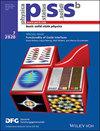Impact of Boron Atom Clustering on the Electronic Structure of (B,In)N Alloys
IF 1.8
4区 物理与天体物理
Q3 PHYSICS, CONDENSED MATTER
引用次数: 0
Abstract
Tailoring the electronic and optical properties of nitride‐based alloys for optoelectronic device applications in the ultraviolet and red spectral range has attracted significant attention in recent years. Adding boron nitride (BN) to indium gallium nitride (In,Ga)N alloys can help to control the lattice mismatch between (In,Ga)N and GaN and may thus allow to reduce strain‐related defect formation. However, understanding of the impact of BN on the electronic properties of III‐N alloys, in particular the influence of experimentally observed boron atom clustering, is sparse. This work presents first‐principles calculations investigating the electronic properties of highly mismatched (B,In)N alloys with boron contents between 2% and 7%. Special attention is paid to the impact of the alloy microstructure. While the results show that the lattice constants of such alloys largely agree with lattice constants determined from a Vegard approximation, the electronic structure strongly depends on the local boron atom configuration. For instance, if boron atoms are dispersed throughout the structure and are not sharing nitrogen atoms, the band gap of (B,In)N alloys is largely unaffected and stays close to the gap of pristine InN. However, in the case of boron atom clustering, i.e., when boron atoms are sharing nitrogen atoms, the band gap can be strongly reduced, often leading to a metallic state in (B,In)N alloys. These strong band gap reductions are mainly driven by carrier localization effects in the valence band. Our calculations thus show that the electronic structure of (B,In)N alloys strongly depends on the alloy microstructure and that boron atom clustering plays an important role in understanding the electronic and optical properties of these emerging materials.硼原子团聚对 (B,In)N 合金电子结构的影响
近年来,为紫外和红外光谱范围内的光电器件应用定制氮化物基合金的电子和光学特性引起了人们的极大关注。在氮化铟镓(In,Ga)N)合金中添加氮化硼(BN)有助于控制(In,Ga)N 和氮化镓之间的晶格失配,从而减少与应变相关的缺陷形成。然而,关于硼对 III-N 合金电子特性的影响,特别是实验观察到的硼原子团聚的影响,人们的了解还很有限。本研究通过第一原理计算,研究了硼含量在 2% 到 7% 之间的高度不匹配 (B,In)N 合金的电子特性。研究特别关注合金微观结构的影响。结果表明,此类合金的晶格常数与根据 Vegard 近似值确定的晶格常数基本一致,但电子结构在很大程度上取决于硼原子的局部构型。例如,如果硼原子分散在整个结构中,且不共享氮原子,(B,In)N 合金的带隙基本不受影响,并与原始 InN 的带隙接近。然而,在硼原子聚集的情况下,即硼原子共享氮原子时,带隙会强烈减小,通常会导致 (B,In)N 合金中出现金属态。这些强烈的带隙减小主要是由价带中的载流子局域化效应驱动的。因此,我们的计算表明,(B,In)N 合金的电子结构在很大程度上取决于合金的微观结构,而硼原子团聚在理解这些新兴材料的电子和光学特性方面发挥着重要作用。
本文章由计算机程序翻译,如有差异,请以英文原文为准。
求助全文
约1分钟内获得全文
求助全文
来源期刊
CiteScore
3.30
自引率
6.20%
发文量
321
审稿时长
2 months
期刊介绍:
physica status solidi is devoted to the thorough peer review and the rapid publication of new and important results in all fields of solid state and materials physics, from basic science to applications and devices. Being among the largest and most important international publications, the pss journals publish review articles, letters and original work as well as special issues and conference contributions.
physica status solidi b – basic solid state physics is devoted to topics such as theoretical and experimental investigations of the atomistic and electronic structure of solids in general, phase transitions, electronic and optical properties of low-dimensional, nano-scale, strongly correlated, or disordered systems, superconductivity, magnetism, ferroelectricity etc.

 求助内容:
求助内容: 应助结果提醒方式:
应助结果提醒方式:


